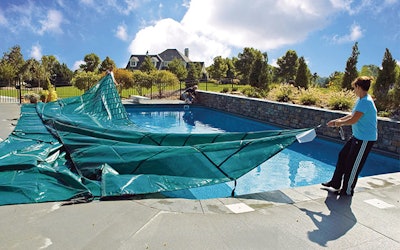
As summer rolls in and temperatures rise, pool professionals in seasonal markets begin turning their attention to ordering winter pool covers — a significant source of income, whether sold in new construction or in the aftermarket.
Interestingly, covers are relatively expensive items that are sold by builders, servicers and retailers alike. And although the selling process unfolds differently in each category, the basic necessity of covering up for winter never really changes.
Mike Mancini, general manager for Fox Pool & Spa Leisure Center in Burlington, Ont., is familiar with selling and installing covers across all three major dealer types.
"We sell covers for all of our new pools, almost without exception. For the aftermarket, we run ads and promotions through our retail store and with service, because we're out there on the property, we'll leave our door hangers or other promotional material. Bottom line is that in areas with cold winters, every pool should have a winterizing cover."
According to Mancini, that necessity equates to strong annual sales across both new construction and the aftermarket, with most of the latter coming as part of the service business. "The sales break down to about 50/50 new pools versus aftermarket," he explains. "For new pools, we will sell either a solid, lock-in cover or a mesh cover. For the aftermarket, usually we're trying to get our clients to upgrade to mesh safety covers.
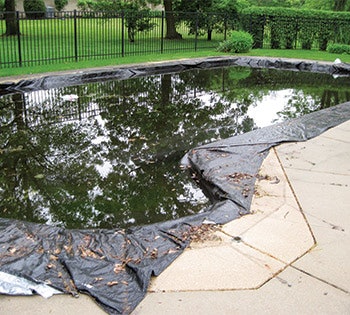 When water and debris are left to collect on traditional solid winter covers, the resulting mess can be become an intolerable eyesore for many homeowners.
When water and debris are left to collect on traditional solid winter covers, the resulting mess can be become an intolerable eyesore for many homeowners.
"We start promoting cover upgrades in August and actually begin closing pools we have on service at the start of September and go through to the end of November," he adds. "Overall, the vinyl lock-in covers are the most popular with our customers. Those work well with vinyl liner pools, where you have the liner with a bead that fits into the second track. Those do seem to be the most popular, but it's definitely switching over to the mesh covers."
According to Herb May, owner of Pools Plus in Bridgeport, Ohio, a firm that builds and services package pools, "99.99 percent of pool owners winterize their pools, it's a given. We build between 10 to 15 pools each year and they all have covers, without exception. Probably 90 percent of those are lock-in covers. I price all pools with a lock-in cover in the contract and if someone wants to go with the more expensive mesh cover, they simply pay the difference."
MESH V. SOLID
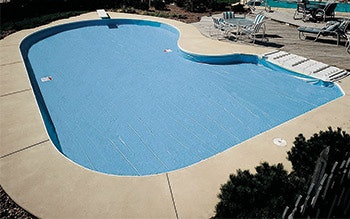 Lock-in-place solid winter covers have become a popular option for homeowners looking for clean aesthetics at a relatively affordable price point.
Lock-in-place solid winter covers have become a popular option for homeowners looking for clean aesthetics at a relatively affordable price point.
When it comes to which type of cover is best, the question typically boils down to a choice between aforementioned mesh and solid covers. Mesh covers are anchored to the deck at multiple points and are known for their safety, strength and durability. Solid covers are either the lock-in bead design or solid pieces of vinyl held down along the edges by water or sand bags.
Note: Those contacted for this story were happy to report that the "water bag" approach has waned significantly in recent years, while the other two common options have continued to increase in popularity. Both solid and mesh covers have distinct and separate advantages, as well as drawbacks.
Solid covers that lock into a bead track, similar to a vinyl liner, are often favored because of their relative affordability and the fact that they prevent all sunlight and debris from entering the pool. That's a huge advantage when it comes opening pools after winter, primarily because algae doesn't form, or if so at a fraction of the rate found in mesh-covered pools.
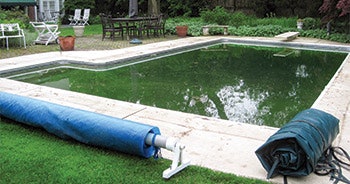 In spring, when covers come off and reveal green water, many service techs and homeowners alike start thinking about cover options that will better preserve quality water conditions.
In spring, when covers come off and reveal green water, many service techs and homeowners alike start thinking about cover options that will better preserve quality water conditions.
The primary disadvantage of solid covers is that while preventing rain, sunlight or debris from entering the pool, they can become laden with water, leaves and dirt, creating an ugly muck that many homeowners find distasteful.
By contrast, mesh covers don't have issues with water and debris buildup, because water flows through the openings in the mesh, preventing puddles and the build up of leaves and other debris that gets caught in standing water. Still, because they are mesh, sunlight will filter through as well, giving rise to algae during winter months.
In recent years, manufacturers of mesh liners have improved on the basic concept by introducing "micro" mesh, which, although still permeable, allows much less sunlight, thus reducing algae growth. (More on that below.) Conversely, some manufacturers of solid covers have developed products that feature mesh panels, which allow drainage, but don't allow sunlight to penetrate the majority of the cover surface area.
POINTS OF DISTINCTION
The preferred cover concept is often based, at least in part, on whether the cover is sold as part of original construction or as an aftermarket upgrade, while region and installation design also play important roles.
"Almost every customer I build a pool for becomes a long-time service customer," explains Al Hildebrand from Poolscape Concepts, a Long Island builder and service company. "New pool owners might be tight on funds and they might go for the water bag cover for the first couple of years, but service clients will almost always upgrade to the mesh cover."
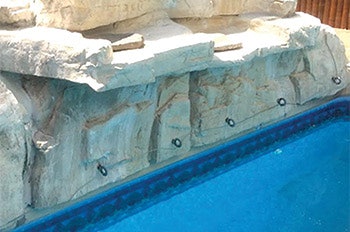 Cover manufacturers have devised simple ways to integrate winterizing covers into many of the design elements found in today's pools, including raised spas, swim outs and artificial rock structures.
Cover manufacturers have devised simple ways to integrate winterizing covers into many of the design elements found in today's pools, including raised spas, swim outs and artificial rock structures.
Mancini agrees: "We probably have about 400 pools on service and it's common for homeowners to start with a solid cover but then upgrade to a mesh cover," he says.
In terms of the advantages that drive that buying pattern, Mancini says, "The big issue is aesthetics. Many people do not like to look at the brackish water that gathers on a solid cover. The standing water mixes with leaves and branches and other debris, it turns black and looks terrible. We're finding that many designs these days are going more to a formal look, at least in our market. When customers go to the trouble of having a very formal looking backyard, they tend to want the mesh cover, again mostly for the aesthetics. Certainly, for many customers, safety is extremely important."
Hildebrand sees it somewhat differently: "Safety is the primary concern, aesthetics is the second biggest issue. I find that customers want covers for both reasons. They want a safe environment and they want it to look good."
Whether for looks, safety, or a clean pool in spring, May sees no reason a homeowner can't have all those advantages if they're willing to pay for them. "Sometimes I'll use a standard mesh safety cover on top of the solid lock-in cover. The mesh allows water and dirt through but is great for safety. By using both types of covers, you get a clean pool in the spring, because of the solid cover, but with the safety of a mesh cover, which will collect far less debris as leaves typically just blow off the mesh cover and don't accumulate in the water that gathers on the solid cover below. You get the benefits of both."
Mancini has found that a mesh cover sale can lead to increased revenues in other ways: "Often, after someone's had a mesh cover for a year to three years they'll come to the retail store and buy the robotic cleaner, which has its own filtration system. After you pull off the cover, you drop the cleaner in the pool and within a few days, you'll have clean water. Usually they try cleaning it themselves once or twice, then say the heck with this and come into the store and spend $1,000 to $1,300 on a robotic cleaner."
ANOTHER FINE MESH
While the three professionals contacted for this discussion differ slightly on some aspects of selling and using covers, they all wholeheartedly agree that the advent of the aforementioned "fine" or "deluxe" mesh covers has changed the overall equation.
In seeking to address concerns about algae and dirt growing and accumulating during the winter, manufacturers have in recent years introduced covers that have much more tightly woven mesh material which serves as a better sunblock.
"I'm personally 100-percent sold on the micro-mesh covers," Hildebrand says. "I wouldn't say they're algae-free but they are much, much better than what you'd find with the larger mesh covers, where the algae could be so bad it'd take two or three weeks to clean them up."
Although May still prefers the cleanliness of solid covers, he too has found value in the fine mesh option: I'm turning to the deluxe mesh, the finer mesh, instead of the solid lock-in cover for some of my clients," he says. "If you use the standard mesh without a solid cover underneath it, you'll close the pool in fall with perfectly clean and clear water but then in spring, it's completely green.
"Part of that," he adds, "is that in this region, we can still have warm days into late November, after pools are closed, and if sunlight is getting through, you will grow algae. The fine mesh covers dramatically reduce that problem, plus they're safe and nothing accumulates on the cover."
COMES A TIME
Although winterizing cover sales can be sliced and diced in different ways depending on the client, region and who's doing the selling, one of the simplistic, yet enduring bottom lines is that covers eventually wear out and need replacing. Dealers are quick to add that's true in spite of the fact that cover longevity has increased over the years as products have improved.
"Often it's just because they need a new cover," May says. "The lock-in, solid covers will last eight to 10 years while the mesh will be in the 15-year range. With so many pools on service, there's always going to be a percentage that will need a new cover prior to winterizing. "
With that fundamental need in mind, May adds that the process of selling covers becomes less about marketing and more about open communication with the client, especially for those on service: "We don't advertise but we do keep track of the age of our customers' covers and we advise them when it's time to buy a new one. That's when we let them know about some of the various options," he says. "It's not about advertising but about communication with customer and keeping track of their needs."
Comments or thoughts on this article? Please e-mail [email protected].












































